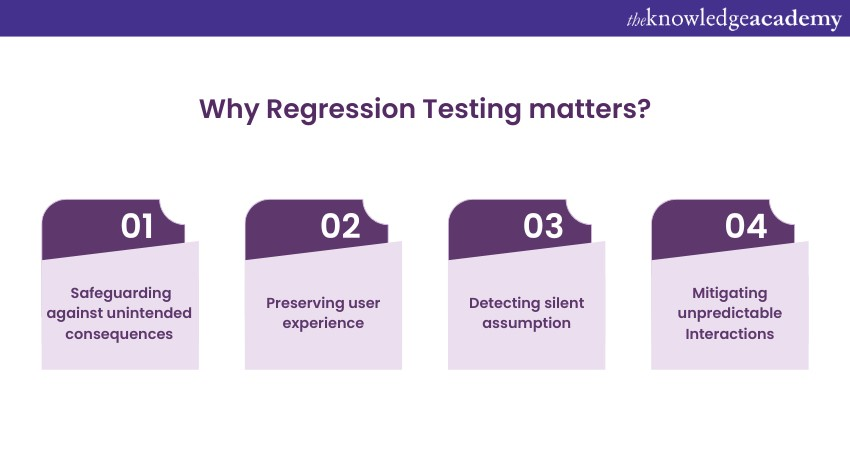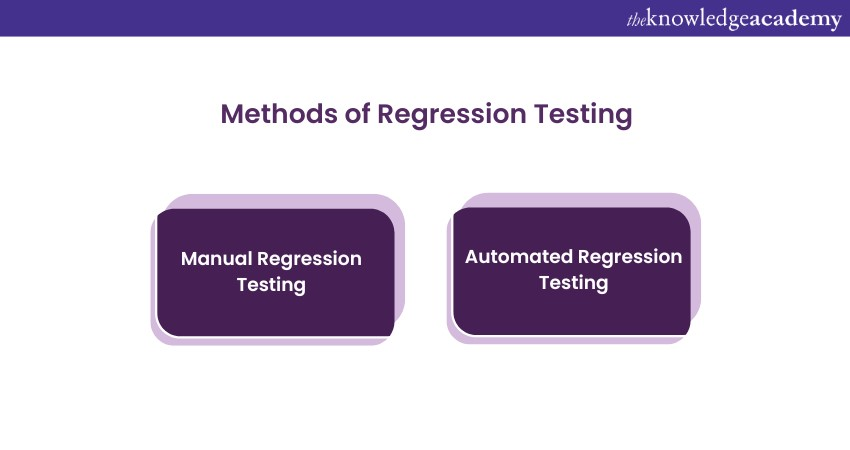We may not have the course you’re looking for. If you enquire or give us a call on +44 1344 203999 and speak to our training experts, we may still be able to help with your training requirements.
Training Outcomes Within Your Budget!
We ensure quality, budget-alignment, and timely delivery by our expert instructors.

In the developing domain of software development, the role of Regression Testing in Software Testing shines as a beacon of reliability. This meticulous process safeguards against unintended consequences, ensuring each code change harmonises with existing functionalities.
In this blog, we will uncover the nuances of Regression Testing, delving into its methods, tools, and challenges. From the art of manual testing to the precision of automation tools, Regression Testing remains a linchpin in the pursuit of seamless software excellence.
Regression Testing in Software Testing is employed to ensure that changes made to the software do not cause new defects or mistakes. Continue reading to learn more!
Table of Contents
1) Introduction to Regression Testing
2) Why Regression Testing matters?
3) Methods of Regression Testing
4) Tools for Regression Testing
5) Challenges in Regression Testing
6) Conclusion
Introduction to Regression Testing
Regression Testing is a cornerstone of the Software Testing domain, representing a comprehensive approach to verifying that recent code changes have not negatively impacted the existing functionalities of an application. It stands as a vigilant sentinel at the gates of software integrity, ensuring that an application's intricate web of interactions and functionalities remains untangled even as new threads are woven into it.
Regression Testing plays a crucial role in ensuring the stability of a software application. Imagine a situation where developers are working hard to improve software by fixing bugs or adding new features. Even though these changes may seem insignificant, they can have a significant impact on the delicate structure of the code, potentially leading to unexpected issues. This is where Regression Testing comes in, making sure that the software continues to function as expected while changes are made.
At its core, Regression Testing involves retesting the application for the new changes and its functionalities. It acts as a time-travelling sentinel, comparing the application's behaviour before and after modifications to identify deviations. Regression Testing illuminates any discrepancies by executing a pre-defined test case suite, uncovering defects that might have slipped through the cracks.
Software applications are in a continuous state of growth. Introducing new features and bug fixes can inadvertently disrupt the equilibrium of existing functionalities. Regression Testing guarantees that the balance is maintained. A seemingly isolated alteration can introduce unexpected side effects. Regression Testing can detect and flag such regressions, preventing minor code changes from spiralling into significant issues.
In an era where user expectations are soaring, a flawless user experience is non-negotiable. Regression Testing cultivates user confidence by verifying that new changes enhance, rather than hinder, the application's usability.
Detecting and resolving defects early in the development cycle is far more economical than addressing them after deployment. Regression Testing's early detection mitigates potential financial and reputational losses. In the world of agile development and continuous integration, rapid and frequent changes are the norm. Regression Testing's efficiency is pivotal in these contexts, ensuring that iterative updates do not destabilise the application.
Ready to elevate your Software Testing skills? With Software Testing Courses & Training, equip yourself with the tools to excel in Regression Testing and beyond.
Why Regression Testing matters?
Imagine a scenario: a diligent team of developers introduces a new feature to an application. This feature undergoes rigorous testing, and all seems well. What if this well-intentioned addition inadvertently triggers a malfunction in another seemingly unrelated part of the application? This is precisely where Regression Testing makes its entrance.

Regression Testing ensures that the intricate web of interactions and functionalities within an application remains unmarred by changes. It functions as a vigilant custodian, tirelessly checking every nook and cranny of the software to unveil unintended side effects. Regression Testing serves as a security net by retesting the application after implemented changes, catching the glitches that might otherwise slip through undetected.
In today's era of ever-increasing user expectations, delivering a seamless and user-friendly experience has become a necessity. Users expect software applications to work flawlessly, irrespective of the new features or improvements introduced. Here is where Regression Testing ensures that user experience remains unblemished.
Regression Testing acts as a guardian of consistency in software development. It plays a crucial role in ensuring that new changes or modifications do not negatively impact the user experience. Whether it's a minor tweak or a substantial overhaul, Regression Testing verifies that the application's core functionalities remain intact, and it preserves the user's trust and satisfaction.
Developing software is a complex process that involves a web of dependencies, interactions, and assumptions. When a developer introduces new code, they often rely on these assumptions about how the application should function. However, these assumptions may not always be accurate, mainly when changes are made elsewhere in the codebase.
Regression Testing confirms that the software still works as expected after changes have been made to it. It also helps identify defects that may have been introduced. By systematically retesting the application, Regression Testing helps uncover discrepancies between expectations and reality, preventing potentially catastrophic failures.
The complexity of modern software systems is mind-boggling. A single change can cascade interactions across various modules and components. These interactions can lead to unintended side effects, causing errors that are difficult to trace and diagnose.
Regression Testing tackles this challenge head-on. It systematically exposes the application to a battery of tests that span its entire functionality. This comprehensive approach catches the apparent issues and the intricate and often unpredictable interactions that can arise from code changes. Regression Testing provides a controlled environment for discovering and addressing these complexities.
The software industry's shift towards agile methodologies and continuous development demands a new level of adaptability. Frequent updates, iterative improvements, and rapid releases have become the norm. However, these practices also raise the risk of inadvertently introducing regressions.
Regression Testing is tailor-made for agile practices. It ensures that the rapid pace of development does not compromise quality. By swiftly identifying regressions, teams can address issues early in the development cycle, minimising the impact on timelines and reducing the cost of rectification.
Uncover the intricacies of software quality assurance and harness the power of automation tools with our Software Testing and Automation Training!
Methods of Regression Testing
Manual Regression Testing entails testers executing a predetermined set of test cases to validate that existing software functionalities remain unaltered after recent code modifications. This method involves hands-on human involvement, resembling an artisan's craft. It offers the advantage of human insight, allowing testers to apply domain knowledge and intuition to identify potential issues.

Manual testing adapts well to last-minute changes and permits exploratory testing, where testers can unearth hidden defects. However, its downsides include being time-consuming, resource-intensive, and susceptible to repetition-induced fatigue.
Automated Regression Testing, in contrast, relies on specialised tools to run a predefined suite of test cases automatically. This method eliminates manual intervention, streamlining the process and ensuring consistent outcomes across multiple test iterations. The efficiency of automation lies in its speed – automated tests can execute much faster than their manual counterparts, providing rapid feedback on code changes.
The reliability of automation shines in its consistency – automated tests follow a scripted path consistently, minimising the risk of human error. Once automated scripts are established, they can be reused for future releases. Nonetheless, automation requires an upfront investment in creating and maintaining test scripts, and its scope might be limited in exploring unforeseen scenarios.
The choice between manual and automated Regression Testing hinges on project specifics. Smaller projects with limited resources may opt for manual testing due to its adaptability and human analytical skills. In contrast, more significant projects with frequent releases might find automated testing more practical due to its speed and consistency.
A hybrid approach is often employed, combining both methods to capitalise on human expertise and efficiency gains. Critical functionalities might undergo manual testing to leverage human insight, while less intricate components are subjected to automated tests for efficiency.
Tools for Regression Testing
In the dynamic realm of Software Testing, where precision and efficiency are paramount, an arsenal of advanced tools for Regression Testing plays a pivotal role. These tools act as force multipliers, enabling testers and developers to execute comprehensive tests, detect regressions, and ensure the stability of software applications.
Selenium is a stalwart in automated Regression Testing, particularly for web applications. This open-source framework provides tools that automate browser actions, simulating user interactions and verifying web functionalities. Testers can conduct consistent and repeatable tests across different browsers and platforms by scripting these interactions. Selenium's versatility and compatibility with multiple programming languages make it an indispensable asset for web-based Regression Testing.
JUnit shines as a unit testing framework in the Java ecosystem that can be seamlessly adapted for Regression Testing purposes. It allows developers to create and execute test suites, enabling the automated verification of Java applications. JUnit excels in its simplicity, providing an intuitive way to define test cases, manage them, and report results. Its integration with build tools and continuous integration systems further streamlines Regression Testing.
TestNG emerges as a powerful alternative for those seeking enhanced functionalities beyond JUnit. TestNG offers parallel test execution, configuration flexibility, and advanced reporting capabilities. This Java testing framework caters to various testing scenarios, including Regression Testing. Its ability to categorise tests, set priorities, and define dependency relationships enhances the efficiency of regression test suites.
Jenkins, a renowned Continuous Integration and Continuous Delivery (CI/CD) tool extends its capabilities beyond automation by seamlessly integrating with Regression Testing workflows. Its ability to schedule and trigger regression tests in response to code changes ensures that the application's stability is assessed early and often. By automating the execution of test suites, Jenkins minimises the human intervention required for repetitive tasks, ensuring consistent and reliable results.
While Apache JMeter is renowned for performance testing, it also finds relevance in Regression Testing, particularly for applications that require rigorous load testing. JMeter's ability to simulate a high user load while executing test scenarios makes it an ideal choice for uncovering regressions under stress. By subjecting the application to simulated user scenarios, JMeter helps identify bottlenecks and potential regressions that might surface only under heavy usage.
Challenges in Regression Testing
The underlying codebase undergoes continuous changes as the software evolves and new features are introduced. While these changes are essential for progress, they also present a challenge regarding test maintenance.
When alterations are made to the software's functionality, it becomes necessary to update the existing test cases. However, this process can be quite time-consuming and resource-intensive, which can lead to a delay between code changes and updated test cases. Furthermore, some test cases may only become relevant over time, which can result in false negatives or potential defects being missed.
Effective Regression Testing requires a comprehensive set of test data that covers a broad spectrum of scenarios. Managing and maintaining this test data, especially in applications with large datasets, can pose a significant challenge.
Ensuring the data remains relevant and representative of real-world usage scenarios demands meticulous effort. Test data that needs to be updated or more accurately reflects user behaviour can lead to incomplete testing and overlooking potential regressions.
The test environment in which regression tests are conducted should mirror the production environment as closely as possible. However, replicating the production environment can be challenging due to differences in hardware, software configurations, and third-party integrations.
Deviations between the test and production environments can lead to discrepancies in test results. Ensuring consistent and reliable test environments is crucial for accurate Regression Testing outcomes.
Regression Testing involves executing test cases to verify the application's existing functionalities. The sheer number of test cases can make the process time-consuming, particularly for complex applications.
Allocating sufficient resources for thorough Regression Testing can be challenging, especially in projects with tight deadlines. Balancing comprehensive testing against time and resource constraints requires careful planning and prioritisation
Conclusion
Regression Testing in Software Testing is an essential aspect of software development. As technology moves forward, the importance of verifying the stability of applications remains unwavering. The methods and tools showcased here reveal possibilities, from human intuition to automated precision. In order to deliver software that stands the test of time, we must navigate challenges and empower ourselves. Embracing Regression Testing is embracing quality, integrity, and the ever-evolving journey of software advancement.
Frequently Asked Questions
Upcoming Programming & DevOps Resources Batches & Dates
Date
 Software Testing Black Belt
Software Testing Black Belt
Thu 16th Jan 2025
Thu 6th Mar 2025
Thu 22nd May 2025
Thu 24th Jul 2025
Thu 25th Sep 2025
Thu 11th Dec 2025







 Top Rated Course
Top Rated Course



 If you wish to make any changes to your course, please
If you wish to make any changes to your course, please


